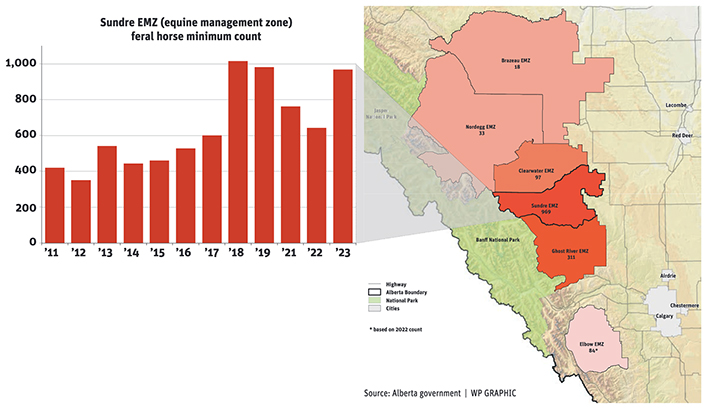The management framework will allow licensed culls under certain circumstances but also includes adoption programs
A plan that the Alberta government says will use science to sustainably and humanely manage some of the largest populations of feral horses in Canada is a step in the right direction, said a rancher.
“I think those horses have earned the right to be here,” said Bryn Thiessen of the Helmer Creek Ranch west of Sundre, Alta. “But if it was just for the horses’ sake, you wouldn’t have people back here, either.”
Related story in this issue: Alta. group questions results of province’s horse survey
The Feral Horse Management Framework is aimed at more than 1,400 free-roaming horses within the Eastern Slopes of Alberta’s Rocky Mountains. Thiessen was part of an advisory committee that provided input for the framework, which was recently released by the Ministry of Forestry and Parks.
The horses are described by the provincial government as feral rather than wild because they are descended from escaped or intentionally released domesticated horses. They were originally used by First Nations, farmers and ranchers and the forestry and mining industries, said a 44-page document detailing the framework.
The initiative is something the Wild Horses of Alberta Society (WHOAS) has sought for a long time, said director Bob Henderson.
“We’ve been asking the government to come up with some sort of strategy to better manage the horses compared to how they were doing it in the past, which was just massive culls and all this other stuff … and this is a good start.”
The provincially licensed culls, which included allowing captured feral horses to be sold for slaughter for food as regulated by the federal government, sparked opposition that included celebrities such as singer Jann Arden. Although the culls were suspended in 2015, the new framework allows the measure under certain circumstances.
“Any decisions around capture of horses will be discussed with the Feral Horse Advisory Committee, including effective capture methods and key populations to manage,” said the framework.
The committee’s members have sought to achieve a balanced approach to the management of feral horses, said Thiessen.
“There’s room for all, not room for small, so if you’re small minded, you’re in trouble.”
Tools under the framework include adoption programs to suitable homes involving advocacy agencies such as WHOAS. The framework also calls for the establishment of a contraception program that will partly build on a pilot project by the group.
WHOAS doesn’t believe there will be a need to cull feral horses, said Henderson, who was also part of the advisory committee.
“There is still a vast area and they’re away from main areas where the cattle allotments are and stuff like that … so, they’re really not hurting anything.”
The framework is based on 12 objectives that include ensuring cattle and domestic livestock are recognized as sharing landscapes along with feral horses and wildlife.
It said recognition must also be given to how economic returns are generated by cattle grazing, wildlife management and public opportunities to view feral horses.
“Overutilization and potential degradation of the land and forage on a multi-use landscape, (with) seasonal domestic cattle grazing, ongoing wildlife and horse use, can exceed what the land can sustain,” said the framework document.

“The decline or loss of grassland ecosystems because of shrub encroachment, invasive species and development pose significant threats to biodiversity.”
The framework follows on the heels of the Rangeland Grazing Framework, which was launched earlier this year to guide provincial policy and procedures for about eight million acres of crown land that can be used to graze livestock.
The Feral Horse Management Framework targets six equine management zones clustered east of the Banff and Jasper national parks. The largest population is in the Sundre zone, which totalled at least 969 feral horses this year, followed by Ghost River at 311, Clearwater at 97, Elbow at 84 (based on counts in 2022), Nordegg at 33 and Brazeau at 18.
Six strategies will help guide the framework’s objectives, including integrating science with Indigenous knowledge and practices.
“Research and knowledge on feral horses in Alberta is improving, yet still incomplete,” said the document.
The framework establishes three population thresholds:
- Threshold 1 involves levels that are acceptable and ecologically sustainable. Horses are monitored, with no active management except for welfare and public safety.
- Threshold 2 targets populations at risk of becoming ecologically unsustainable if left unmanaged, with a focus on proactive actions to ensure they don’t continue to increase. These include a contraception program, adoption program and monitoring.
- Threshold 3 represents unacceptable levels that aren’t ecologically sustainable. Immediate and proactive actions are required to reduce herd size and/or density, including humane removal of horses to bring populations below threshold 2. Key actions include licensed capture, sale of horses and other measures as necessary.
The thresholds are set under different numbers for each of the six equine management zones. For example, threshold 1 for Sundre is 628 and threshold 2 is 1,000 compared to 18 and 30 for Brazeau.
Animals that are injured, unhealthy and unadoptable will be assessed by advocacy agencies “through a license to take the horse, have veterinarian treatment and then move to adoption. If the horse is not fit for treatment, it will be euthanized.”
Visit https://open.alberta.ca/publications/feral-horse-management-framework for a copy of the framework.


















